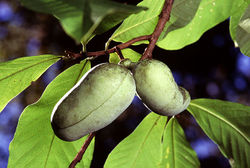Introduction to Paw Paw
The pawpaw tree is indigenous to several areas of North America. Some have theorized that it receives its name due to its similar appearance to the papaya fruit; however, the two fruits are totally unrelated. Pawpaw is of the scientific family Annonaceae, which includes several unusual tropical fruits.
 There are about eight different species of pawpaw; however it is the species Asimina triloba that was used by Dr. Jerry McLaughlin in his research, and it is only this species that contains the special annonaceous acetogenins that have been shown to so powerful in fighting insects, cancer cells, parasites, lice, and other attackers. The pawpaw is a cousin to the fruit known as graviola, but research has proven that although graviola has some similar natural chemical compounds, it is not as desirable or as powerful as Asimina triloba for medical use. Unfortunately, however, some opportunistic companies will market graviola as an equal. It is not. (See comments by Dr. McLaughlin on the difference between graviola and pawpaw.)
There are about eight different species of pawpaw; however it is the species Asimina triloba that was used by Dr. Jerry McLaughlin in his research, and it is only this species that contains the special annonaceous acetogenins that have been shown to so powerful in fighting insects, cancer cells, parasites, lice, and other attackers. The pawpaw is a cousin to the fruit known as graviola, but research has proven that although graviola has some similar natural chemical compounds, it is not as desirable or as powerful as Asimina triloba for medical use. Unfortunately, however, some opportunistic companies will market graviola as an equal. It is not. (See comments by Dr. McLaughlin on the difference between graviola and pawpaw.)
The trees themselves are not large as far as trees go. Some are about the size of large shrubs, although many grow as high as 25 feet, and sometimes a little more. The fruit itself is about the size of a large human fist--usually 3-6 inches long-- and is considered by many to be very tasty. It is often compared to a combination of some sort of banana, coconut, mango, and possibly others. One reason that it is not available too often in retail settings is that it spoils quickly after it is harvested. However, those who are fortunate enough to find a ripe fruit on a tree and eat it fresh are usually rewarded with a very pleasant tasting experience.
The fruit is also highly nutritious--very rich in proteins, good fats, and complex carbohydrates. It is normally ripe in the fall, usually in September. The explorers Meriwether Lewis and William Clark were known to have survived on pawpaw for about a month during their famous exploratory trip.
As a child, Jerry McLaughlin ate the fruit and felt that there must be something biologically active. As a Professor of Pharmacognosy at Purdue University, he spent over 20 years studying this fruit. He discovered the presence of a natural chemical in the tree called an acetogenin. An acetogenin is a long-chained, fatty acid substance with some very unique properties. Over 400 of these compounds have been found in nature, many of them by researchers working with Dr. McLaughlin at Purdue University. In other parts of the world, researchers have been looking for acetogenins in other fruits of the same family. However, the double-ringed features of the powerful acetogenins in the Asimina triloba have not been found to date in those other fruits.
Interestingly enough, the acetogenins that are so powerful are not as plentiful in the fruit as in the twigs of the tree. Also, Dr. McLaughlin found that the acetogenin levels peaked in the twigs during the month of May. Just as important, he found the levels of acetogenins vary even by location of the Asimina triloba trees. Some groves produce higher levels than others. Thus, if someone is considering using pawpaw as a treatment, it is not only important to ensure that the product is from the Asimina triloba species of pawpaw, but also that the product is standardized--in other words, the manufacturer uses an extraction process for the acetogenins and ensures that a guaranteed set amount (standardized amount) of acetogenins is actually in the product. At this point, only one manufacturer in the world has the capability of accomplishing this, partially because Dr. McLaughlin has licensed his patent and methodology to them.
Due to the unique characteristics of the acetogenins, they have been used for several different applications. Read more about uses of pawpaw.